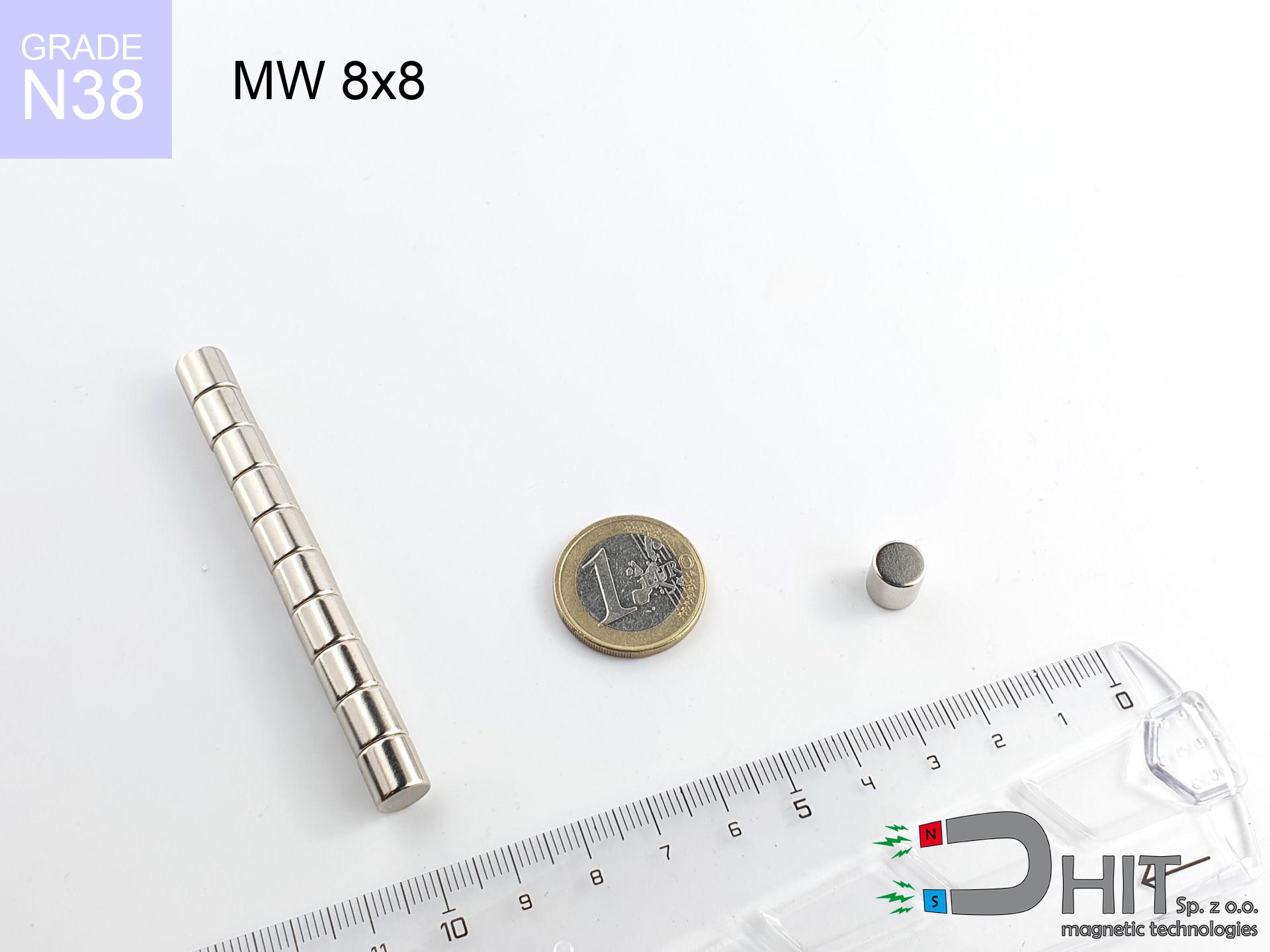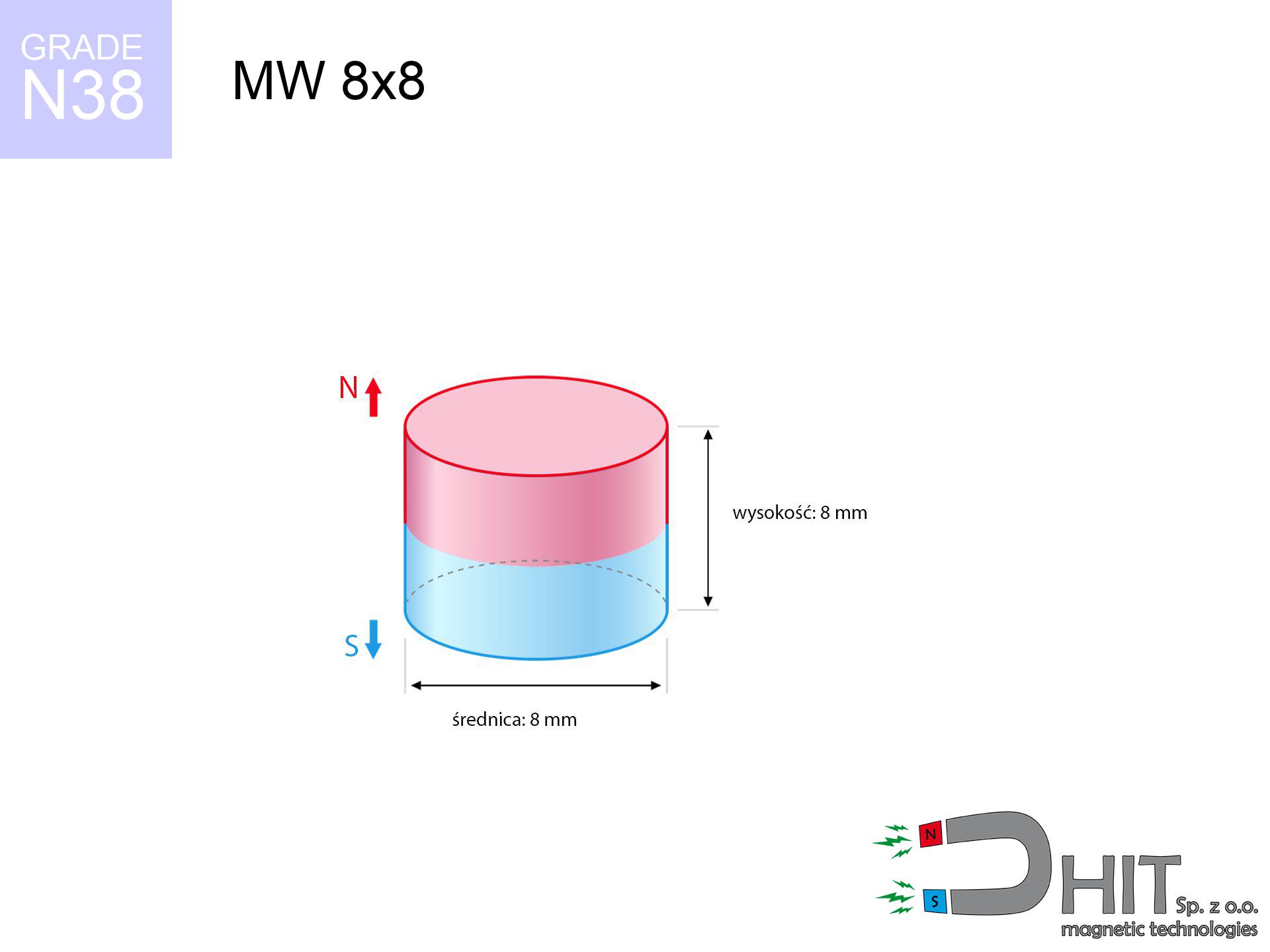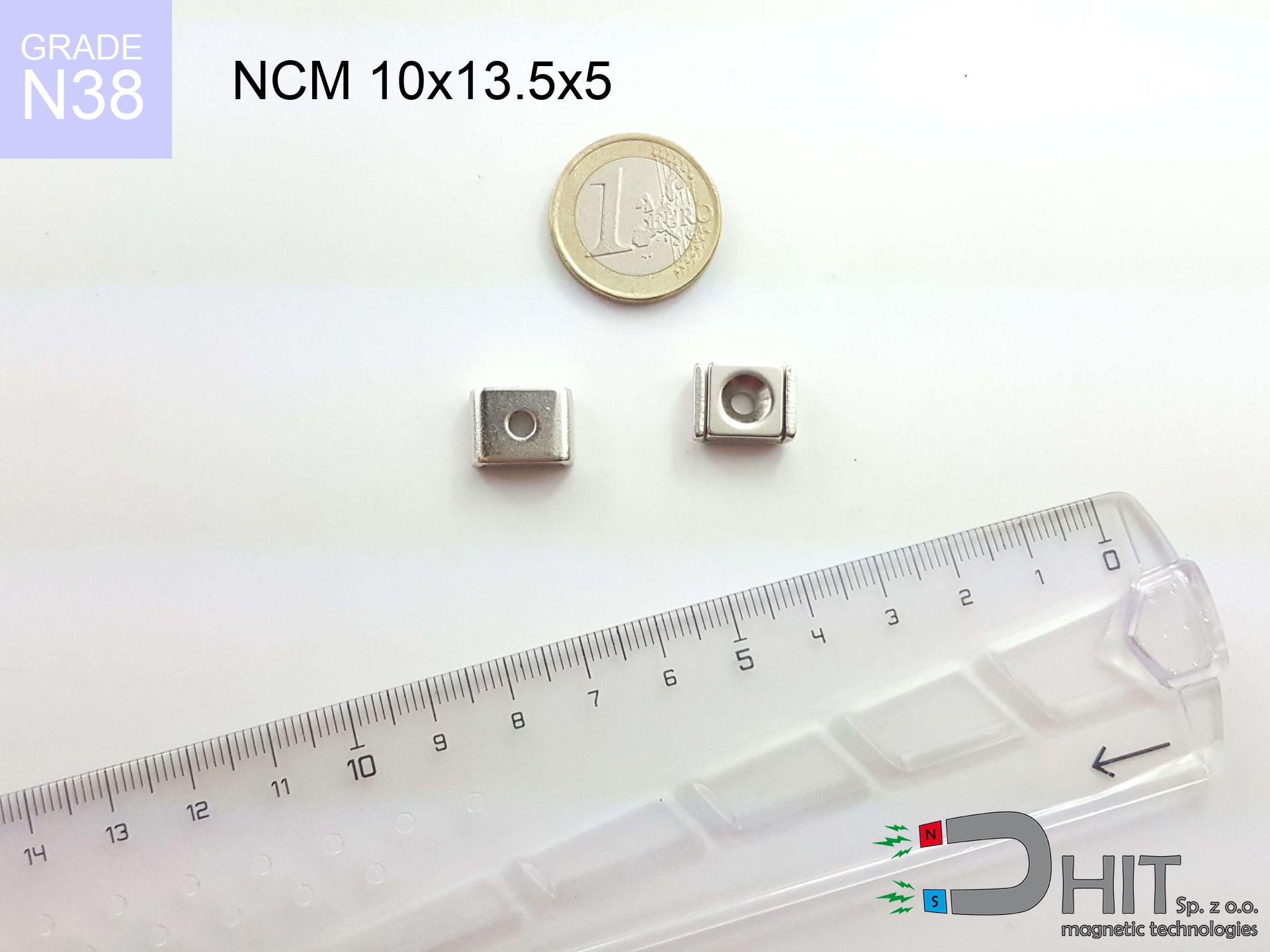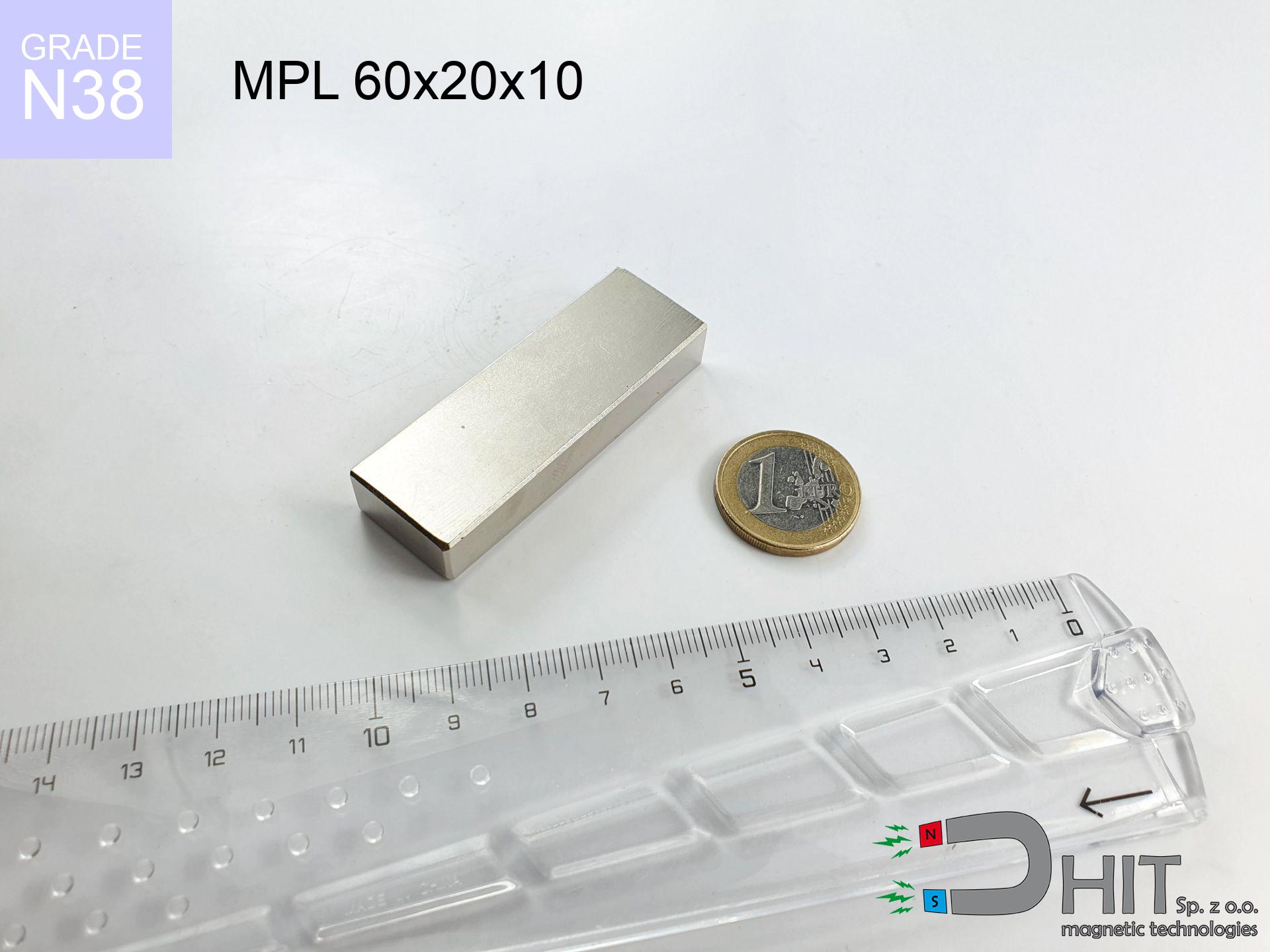MW 8x8 / N38 - cylindrical magnet
cylindrical magnet
Catalog no 010106
GTIN: 5906301811053
Diameter Ø
8 mm [±0,1 mm]
Height
8 mm [±0,1 mm]
Weight
3.02 g
Magnetization Direction
↑ axial
Load capacity
3.54 kg / 34.72 N
Magnetic Induction
553.67 mT
Coating
[NiCuNi] nickel
1.341 ZŁ with VAT / pcs + price for transport
1.090 ZŁ net + 23% VAT / pcs
bulk discounts:
Need more?Need advice?
Pick up the phone and ask
+48 22 499 98 98
otherwise contact us via
form
the contact form page.
Parameters and structure of a neodymium magnet can be estimated with our
magnetic mass calculator.
Same-day shipping for orders placed before 14:00.
Magnetic properties of material N38
Physical properties of sintered neodymium magnets Nd2Fe14B at 20°C
Shopping tips
Advantages as well as disadvantages of neodymium magnets.
In addition to their magnetic efficiency, neodymium magnets provide the following advantages:
- They virtually do not lose power, because even after ten years the performance loss is only ~1% (based on calculations),
- Neodymium magnets remain extremely resistant to demagnetization caused by external field sources,
- Thanks to the elegant finish, the plating of Ni-Cu-Ni, gold-plated, or silver-plated gives an modern appearance,
- Magnets have impressive magnetic induction on the outer layer,
- Through (appropriate) combination of ingredients, they can achieve high thermal resistance, allowing for functioning at temperatures reaching 230°C and above...
- Considering the ability of flexible molding and customization to unique projects, NdFeB magnets can be modeled in a wide range of shapes and sizes, which makes them more universal,
- Wide application in modern technologies – they are used in hard drives, electric motors, precision medical tools, and industrial machines.
- Compactness – despite small sizes they generate large force, making them ideal for precision applications
What to avoid - cons of neodymium magnets and ways of using them
- To avoid cracks under impact, we recommend using special steel housings. Such a solution protects the magnet and simultaneously increases its durability.
- When exposed to high temperature, neodymium magnets experience a drop in strength. Often, when the temperature exceeds 80°C, their power decreases (depending on the size and shape of the magnet). For those who need magnets for extreme conditions, we offer [AH] versions withstanding up to 230°C
- When exposed to humidity, magnets start to rust. To use them in conditions outside, it is recommended to use protective magnets, such as those in rubber or plastics, which prevent oxidation as well as corrosion.
- Limited possibility of creating threads in the magnet and complicated forms - recommended is a housing - mounting mechanism.
- Health risk resulting from small fragments of magnets are risky, in case of ingestion, which is particularly important in the aspect of protecting the youngest. Additionally, small elements of these devices are able to disrupt the diagnostic process medical in case of swallowing.
- Higher cost of purchase is a significant factor to consider compared to ceramic magnets, especially in budget applications
Best holding force of the magnet in ideal parameters – what contributes to it?
Breakaway force is the result of a measurement for ideal contact conditions, assuming:
- using a sheet made of low-carbon steel, serving as a ideal flux conductor
- whose transverse dimension reaches at least 10 mm
- with a plane cleaned and smooth
- without the slightest air gap between the magnet and steel
- for force applied at a right angle (in the magnet axis)
- in stable room temperature
Practical lifting capacity: influencing factors
During everyday use, the real power depends on many variables, ranked from crucial:
- Gap between surfaces – even a fraction of a millimeter of separation (caused e.g. by varnish or unevenness) significantly weakens the pulling force, often by half at just 0.5 mm.
- Force direction – catalog parameter refers to detachment vertically. When slipping, the magnet exhibits significantly lower power (often approx. 20-30% of maximum force).
- Wall thickness – thin material does not allow full use of the magnet. Magnetic flux passes through the material instead of converting into lifting capacity.
- Metal type – different alloys attracts identically. Alloy additives worsen the attraction effect.
- Smoothness – ideal contact is possible only on smooth steel. Any scratches and bumps reduce the real contact area, weakening the magnet.
- Heat – NdFeB sinters have a sensitivity to temperature. At higher temperatures they are weaker, and at low temperatures gain strength (up to a certain limit).
* Lifting capacity was assessed with the use of a steel plate with a smooth surface of suitable thickness (min. 20 mm), under perpendicular detachment force, in contrast under shearing force the load capacity is reduced by as much as 5 times. In addition, even a small distance {between} the magnet’s surface and the plate lowers the lifting capacity.
H&S for magnets
Medical implants
Health Alert: Strong magnets can turn off pacemakers and defibrillators. Do not approach if you have medical devices.
Metal Allergy
It is widely known that the nickel plating (standard magnet coating) is a potent allergen. If you have an allergy, avoid touching magnets with bare hands or select coated magnets.
Data carriers
Very strong magnetic fields can erase data on payment cards, HDDs, and storage devices. Stay away of min. 10 cm.
Magnets are brittle
Despite the nickel coating, neodymium is delicate and cannot withstand shocks. Do not hit, as the magnet may shatter into hazardous fragments.
Handling guide
Exercise caution. Neodymium magnets attract from a long distance and snap with massive power, often quicker than you can move away.
Permanent damage
Watch the temperature. Heating the magnet above 80 degrees Celsius will destroy its magnetic structure and strength.
Dust is flammable
Drilling and cutting of neodymium magnets poses a fire risk. Neodymium dust reacts violently with oxygen and is hard to extinguish.
Do not give to children
NdFeB magnets are not toys. Eating several magnets can lead to them attracting across intestines, which poses a direct threat to life and requires urgent medical intervention.
Crushing risk
Big blocks can break fingers instantly. Under no circumstances put your hand betwixt two attracting surfaces.
Threat to navigation
Navigation devices and smartphones are extremely susceptible to magnetic fields. Close proximity with a strong magnet can ruin the sensors in your phone.
Important!
More info about risks in the article: Magnet Safety Guide.







![UMP 135x40 [M10+M12] GW F600 Lina / N38 - search holder UMP 135x40 [M10+M12] GW F600 Lina / N38 - search holder](https://cdn3.dhit.pl/graphics/products/ump-135x40-m10+m12-gw-f600-+lina-sej.jpg)

